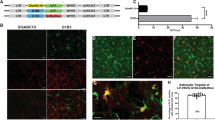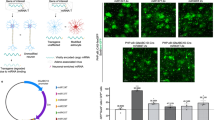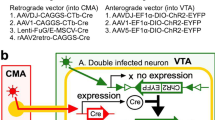Abstract
Replication defective viral vectors provide a potentially useful means of gene transfer to oligodendrocytes and thus for studying the pathogenesis of white matter disease. In this study we have examined the expression pattern of E1/E3 deleted adenoviral vectors expressing the reporter gene LacZ (AdlacZ) as a means of establishing the value of these vectors for gene delivery to oligodendrocytes in adult rat white matter. Our results indicate that although such an approach can be used to induce transgene expression in oligodendrocytes, it is complicated by both immunogenic and cytopathic effects. Thus, in normal animals, injection of ΔE1/E3 adenoviral vectors was associated with a robust immune response that led to a lack of expression by 40 days after injection. In order to overcome this complication, virus was injected into the white matter of immuno-deficient athymic rats. These experiments indi- cated that even in the absence of a T cell response high viral titres of ΔE1/E3 adenoviral vectors had a profound cytopathic effect leading to death of oligodendrocytes and hence demyelination. A similar cytopathic effect was demonstrated using an adenoviral vector expressing the neurocytokine ciliary neurotrophic factor (AdCNTF). As the titre of injected virus was decreased there was a significant decrease in the number of transgene expressing cells. These experiments therefore indicated that in immunodeficient recipients there is a narrow window of virus titre that results in a high rate of infectivity and expression without significant cytopathic consequences. At higher viral titres the cytopathic effects include oligodendrocyte death and demyelination, while at lower titres there is a significant decrease in the efficiency of the number of cells expressing the transgene.
This is a preview of subscription content, access via your institution
Access options
Subscribe to this journal
Receive 12 print issues and online access
$259.00 per year
only $21.58 per issue
Buy this article
- Purchase on Springer Link
- Instant access to full article PDF
Prices may be subject to local taxes which are calculated during checkout
















Similar content being viewed by others
References
Yang N-S . Gene transfer into mammalian somatic cells in vivo Crit Rev Biotech 1992 12: 335–356
Gunzburg WH, Salmons B . Virus vector design in gene therapy Mol Med Today 1995 1: 410–417
Kozarsky KF, Wilson JM . Gene therapy: adenovirus vectors Current Biol 1993 3: 499–503
Le Gal La Salle G et al. An adenovirus vector for gene transfer into neurons and glia in the brain Science 1993 259: 988–990
Akli S et al. Transfer of a foreign gene into the brain using adenovirus vectors Nat Genet 1993 3: 224–228
Davidson BL et al. A model system for in vivo gene transfer into the central nervous system using an adenoviral vector Nat Genet 1993 3: 219–223
Hermens WTJMC et al. Transient gene transfer to neurons and glia: analysis of adenoviral vector performance in the CNS and PNS J Neurosci Meth 1997 71: 85–98
Hashimoto M et al. A neural cell-type-specific expression system using recombinant adenovirus vectors Hum Gene Ther 1996 7: 149–158
Byrnes AP, Rusby JE, Wood MJA, Charlton HM . Adenovirus gene transfer causes inflamation in the brain Neurosci 1995 66: 1015–1024
Byrnes AP, MacLaren RE, Charlton HM . Immunological instability of persistent adenovirus vectors in the brain: peripheral exposure to vector leads to renewed inflammation, reduced gene expression, and demyelination J Neurosci 1996 16: 3045–3055
Wood MJ et al. Immune responses to adenovirus vectors in the nervous system Trends Neurosci 1996 19: 497–501
Peltekian E et al. Adenovirus mediated gene transfer to the brain: methodological assessment J Neurosci Meth 1997 71: 77–84
Hermens WTJMC, Verhaagen J . Adenoviral vector-mediated gene expression in the nervous system of immunocompetent Wistar and T cell-deficient nude rats: preferential survival of transduced astroglial cells in nude rats Hum Gene Ther 1997 8: 1049–1063
Louis J-C, Magal E, Takayama S, Varon S . CNTF protection of oligodendrocytes against natural and tumor necrosis factor-induced death Science 1993 259: 689–692
Barres BA et al. Ciliary neurotrophic factor enhances the rate of oligodendrocyte generation Mol Cell Neurosci 1996 8: 146–156
Franklin RJM, Barnett SC . The electron microscopic appearance of the beta-galactosidase reaction product Acta Neuropathol 1991 81: 686–687
Franklin RJM, Bayley SA, Blakemore WF . Transplanted CG4 cells (an oligodendrocyte progenitor cell line) survive, migrate, and contribute to repair of areas of demyelination in X-irradiated spinal cord but not in normal spinal cord Exp Neurol 1996 137: 263–276
Franklin RJM, Blakemore WF . Requirements for Schwann cell migration within CNS environments: a viewpoint Int J Dev Neurosci 1993 11: 641–649
Haase G et al. Gene therapy of murine motor neuron disease using adenoviral vectors for neurotrophic factors Nature Med 1997 3: 429–436
Bajocchi G, Feldman SH, Crystal RG, Mastrangeli A . Direct in vivo gene transfer to ependymal cells in the central nervous system using recombinant adenovirus vectors Nat Genet 1993 3: 229–234
Haase G et al. Therapeutic benefit of CNTF in progressive motor neuronopathy depends on the route of delivery Ann Neurol 1999 45: 296–304
Shy ME et al. An adenoviral vector can transfer lacZ expression into Schwann cells in culture and in sciatic nerve Ann Neurol 1995 38: 429–436
Sorensen J et al. Gene transfer to Schwann cells after peripheral nerve injury: a delivery system for therapeutic agents Ann Neurol 1998 43: 205–211
Guo Z et al. Efficient and sustained transgene expression in mature rat oligodendrocytes in primary culture J Neurosci Res 1996 43: 32–41
Jenkins HG, Ikeda H . Tumor necrosis factor causes an increase in axonal transport of protein and demylination in the mouse optic nerve J Neurol Sci 1992 108: 99–104
Zajicek JP, Wing M, Scolding NJ, Compston DAS . Interactions between oligodendrocytes and microglia: a major role for complement and tumour necrosis factor in oligodendrocyte adherence and killing Brain 1992 115: 1611–1631
Monastra G, Cross AH, Bruni A, Raine CS . Phosphatidylserine, a putative inhibitor of tumor necrosis factor, prevents autoimmune demyelination Neurology 1993 43: 153–163
Liu JL et al. TNF is a potent anti-inflammatory cytokine in autoimmune-mediated demyelination Nature Med 1998 4: 78–83
Bansal R, Pfeiffer SE . FGF-2 converts mature oligodendrocytes to a novel phenotype J Neurosci Res 1997 50: 215–228
Muir DA, Compston DAS . Growth factor stimulation triggers apoptotic cell death in mature oligodendrocytes J Neurosci Res 1996 44: 1–11
Yao D-L, Liu X, Hudson LD, Webster HD . Insulin-like growth factor I treatment reduces demyelination and up-regulates gene expression of myelin-related proteins in experimental autoimmune encephalomyelitis Proc Natl Acad Sci USA 1995 92: 6190–6194
Fressinaud C, Vallat JM, Pouplard-Barthelaix A . Platelet-derived growth factor partly prevents chemically induced oligodendrocyte death and improves myelin-like membranes repair in vitro Glia 1996 16: 40–50
Woodruff RH, Franklin RJM . Growth factors and remyelination in the CNS Histol Histopath 1997 12: 459–466
Butt AM, Ransom BR . Visualisation of oligodendrocytes and astrocytes in the intact rat optic nerve by intracellular injection of lucifer yellow and horseradish peroxidase Glia 1989 2: 470–475
Caillaud C et al. Adenoviral vector as a gene delivery system into cultured rat neuronal and glial cells Eur J Neurosci 1993 5: 1287–1291
Byrnes AP, Wood MJ, Charlton HM . Role of T cells in inflammation caused by adenovirus vectors in the brain Gene Therapy 1996 3: 644–651
Yang Y et al. Cellular immunity to viral antigens limits E1-deleted adenoviruses for gene therapy Proc Natl Acad Sci USA 1994 91: 4407–4411
Gilgenkrantz H et al. Transient ecpression of genes transferred in vivo into heart using first-generation adenoviral vectors: role of the immune response Hum Gene Ther 1995 6: 1265–1274
Kay MA et al. Long-term hepatic adenovirus-mediated gene expression in mice following CTLA41g administration Nat Genet 1998 11: 191–197
Boviatsis EJ et al. Gene transfer into experimental brain tumors mediated by adenovirus, herpes simplex virus, and retrovirus vectors Hum Gene Ther 1994 5: 183–191
Kochanek S et al. A new adenoviral vector: replacement of all viral coding sequences with 28kb of DNA independently expressing both full-length dystrophin and beta-galactosidase Proc Natl Acad Sci USA 1996 93: 5731–5736
Kaplitt MG et al. Long-term gene expression and phenotypic correction using adeno-associated virus vectors in the mammalian brain Nat Genet 1994 8: 148–154
Naldini L et al. In vivo gene delivery and stable transduction of nondividing cells by a lentiviral vector Science 1996 272: 263–267
Stratford-Perricaudet LD et al. Evaluation of the transfer and expression in mice of an enzyme-encoding gene using a human adenovirus vector Hum Gene Ther 1990 1: 241–256
Lisovoski F et al. Phenotypic alteration of astrocytes induced by ciliary neurotrophic factor in the intact adult brain, as revealed by adenovirus-mediated gene transfer J Neurosci 1997 17: 7228–7236
Acknowledgements
The authors would like to thank Professor A Kahn, Professor WF Blakemore and Dr MT O’Leary for their support and helpful discussion and L Castelnau-Ptakhine, M Peacock and C Ready for excellent technical help. This work was supported by the Wellcome Trust, Association Française contre les Myopathies and a Research Travel Award from the British Neuropathological Society. RJMF is a Wellcome Research Career Development Fellow.
Author information
Authors and Affiliations
Rights and permissions
About this article
Cite this article
Franklin, R., Quick, M. & Haase, G. Adenoviral vectors for in vivo gene delivery to oligodendrocytes: transgene expression and cytopathic consequences. Gene Ther 6, 1360–1367 (1999). https://doi.org/10.1038/sj.gt.3300971
Received:
Accepted:
Published:
Issue Date:
DOI: https://doi.org/10.1038/sj.gt.3300971
Keywords
This article is cited by
-
Significant alterations of biodistribution and immune responses in Balb/c mice administered with adenovirus targeted to CD40(+) cells
Gene Therapy (2008)
-
Helper-dependent adenovirus vectors: their use as a gene delivery system to neurons
Gene Therapy (2000)
-
Adenoviral vectors: prospects for gene delivery to the central nervous system
Gene Therapy (1999)



